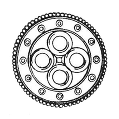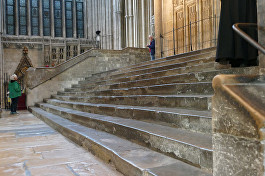CANTERBURY HISTORICAL
& ARCHAEOLOGICAL SOCIETY (CHAS)









Basics
Geology: freshwater shelly imestone
Rock unit: Durlston Formation
Age: Lower Cretaceous
Provenance: Isle of Purbeck, Dorset
Where to see examples
The texts describing the colours of Purbeck Marble differ in their naming conventions. That adopted here is the acceptance of a a blue bed, a grey bed and a green bed all containing shells of the gastropod Viviparous. Correlation of each slab to a particular bed is not always achievable as even the colour schemes can be confusing. Many of the slabs at Canterbury, notably in the steps leading from the nave to the pulpitum are red in colour. These stones are recognised as being from the green bed. The green colouration of freshly quarried stone from these beds is derived from reworked glauconite, an iron-rich mineral which is green in colour. Following installation and iron has oxidised to provide a deep red colouration. Geopetal features (see Bethersden Marble) can occasionally be found in Purbeck Marble. While the predominant fossils are gastropod shells and bivalve shells (Unio) occasionally slabs of Pubeck Marble can show more ‘exotic’ fossil remains; one stone set into steps in the south choir aisle displays several fish teeth and a broken tooth from a hybodont shark (photo available).
For a further description of this stone click here
Purbeck Marble – for floors
 HOME
CONTACT US
MAIN SITE
HOME
CONTACT US
MAIN SITE
click to enlarge and read caption
© Geoff Downer 2019

